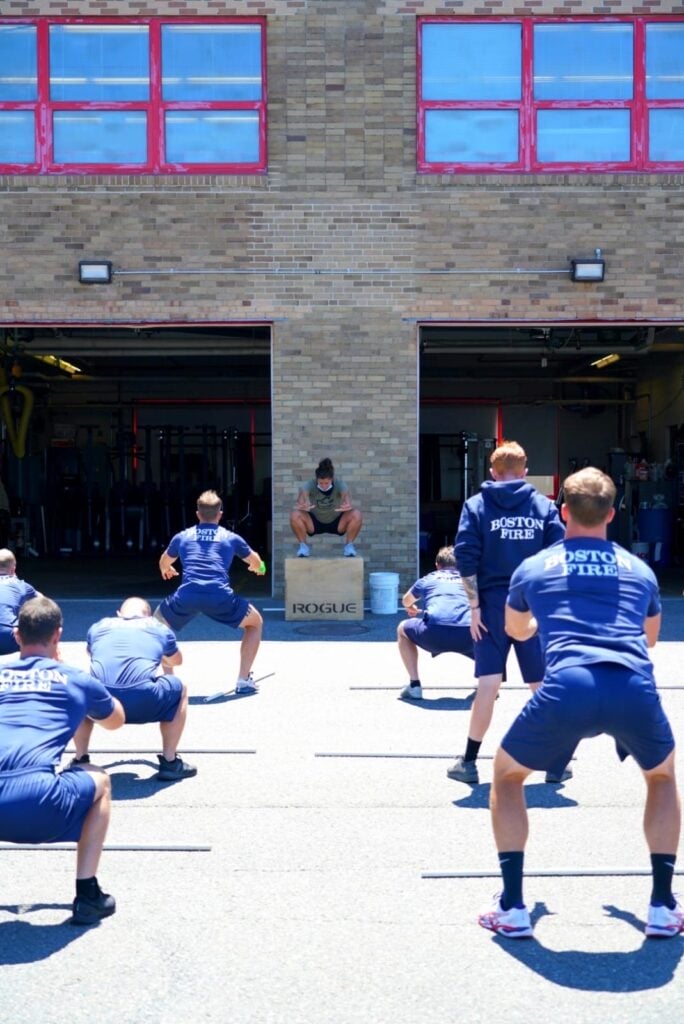Quality Over Quantity: How to Make the Most of Your Workout in a Limited Time

By O2X Program Manager Frank Wintrich
Developing and maintaining a high level of physical readiness not only provides numerous health benefits and reduces the risk of cardiovascular disease but also helps boost morale and self-esteem.
For firefighters, the success of their work, lives, and the lives of their teammates and community depend on maintaining peak physical condition to perform their best at any moment. With an enduring need to call forth the sudden, intense energy needed to fight a fire, perform a vehicle extraction, or carry an injured person, a firefighter in poor physical condition could be a grave danger to not only himself but his teammates as well.
One of the biggest challenges faced in programming for tactical athletes like firefighters is dealing with uncontrollable factors in their work schedules. Uncontrollable factors can be training evolutions, duty shift changes, or unexpected calls. In the case of calls, while on duty, a firefighter never knows when the bell will ring to send them into action. Ensuring readiness through training effectively and efficiently is paramount. So how do we develop and maintain a high level of fitness, while not diminishing our readiness? Here are four tips for developing a program that can fit your duty schedule while maximizing your training.


Tip 1: Make your warm-up more than a warm-up
First question, are you warming up before you train? If not, consider the benefits of a well-designed warm-up:
- Deliberate preparation for the day’s training
- Develop and improve bio-motor abilities utilized in the training session such as strength and power, neuromuscular coordination, speed and agility, flexibility and dynamic mobility, balance and stability, energy system development (fitness)
- Improve time management by increasing the quality of your reps
- Decrease the risk of injury
- Facilitate performance rather than inhibit performance
BLUF (Bottom Line Up Front) – you need to be warming up before you train. Building that warm-up around the goals of your training will maximize the efficiency of your session.
For a running, speed, or agility session utilize this strategy:
- Start with Low Intensity Transit Exercise – light movements down the field or track
- Progress to Muscle Activation – Closed chain, in-place movements that focus on specific muscle groups used in the upcoming session or areas where you have pain or need to improve strength.
- Then add Moderate Intensity Transit Exercise – pick up the tempo from Step 1. Implement some more complex movements that are similar to the targeted movements of the day and begin to dial in your technique but at a lower intensity.
- Increase the Intensity of the Muscle Activation – Open chain, in-place movements that focus on specific muscle groups used in the upcoming session or areas where you have pain or need to improve strength.
- Finish with Higher Intensity Transit Exercises and Drills – These drills should most closely mimic the training activity of the day.
For a lifting session utilize this strategy:
Utilizing the principle of potentiation (increasing strength to neural pathways previously utilized) helps you not only optimally prepare for your upcoming session but improve your work capacity and overall strength. By using a higher rep scheme, this method also improves ligament and tendon density through specific conditioning for the muscle groups you are training that day. This also increases the temperature of the muscles you are training. If a muscle is hotter, it is more pliable which makes it less likely to get injured and perform better. Finally, this method improves overall fitness.
Select three different exercises and perform four sets of 25 reps at the beginning of your training session. Pick a weight that is very light and move from movement to movement for 12 – 15 minutes until you complete all 300 reps.
An example for an upper body press session would look like this:
- Triangle Grip Front Lat Pull Down
- Cable Triceps Extension
- DB or Machine Incline Press
Run or lift, your warmup should last 10 – 15 minutes.
Tip 2: Utilize coupled movements
One of my favorite ways to build programs is to couple movements together to not only create a more intense training effect, but also to train antagonistic muscle groups together. This not only improves training density (how much work you get done in a given time frame) but also ensures that you are balancing out your training. To do this, select a primary movement – let’s stick with our example above of an upper body press. When pressing, the chest, shoulder, back and triceps are utilized. The antagonist muscles would be the back, posterior shoulders, and biceps. A coupling of these would look like this:
- DB Incline Press
- Chin Up
- DB Single Arm Row
I always aim to get 1.5 – 2 times more pulls than presses in my programming. This ensures proper development of postural muscles, building a strong posterior chain and reducing the risk of injury. Based on your training goals, perform the necessary sets and reps for each movement, without taking a break until you get back to the first exercise.
Tip 3: Build Your “conditioning” into your Training
A lot of times when developing training we think of “strength” and “conditioning” work as being separate when in reality the two are intimately tied together. Ultimately, the ability to express strength, especially over an extended period of time (think a long call), is dependent on the body’s ability to develop energy (conditioning). So why not train them both together? As you’ve seen in previous examples, selecting multiple movements, and performing them for either higher volumes, shorter rest intervals or both, is an effective strategy for increasing training density (how much work can be done during a given period of time) and improving overall fitness. Look at your current training program and see places where you can be more efficient and where limiting your rest can increase your gains and decrease the amount of time you are in the gym. Unless required for a specific exercise, never sit in the gym. Avoid unnecessary distractions like scrolling social media or chatting between sets. These are major time drains and are wholly unproductive.
Tip 4: Leave something in the tank
“Feel like you’re ready to fight a war, not like you just went through one.” Too often there is a belief that the end state of a “good” training session is a feeling of being wrecked or not being able to do another thing the rest of the day. While training like this can occasionally serve a purpose, more often than not this path leads to injury and a perpetual state of stagnation. I’m a firm believer in the principle of “Lowest Effective Dose” which is the least amount of time and energy dedicated to a training session while yielding a positive outcome. Evaluate how you feel the day after training. If you are sore, but the soreness resolves with movement (warm-up), you did it right. If your muscles and joints still hurt after you’ve warmed up, dial it back a bit and re-engage. Utilizing this strategy enables me to be more consistent in my training, make appropriate small changes to my training plan and avoid injuries that set me back weeks or even months. Most importantly, as a firefighter, you can be ready whenever the call to spring into action comes.
About Frank Wintrich:
Frank Wintrich is an O2X On-Site Human Performance Specialist who specializes in Strength & Conditioning. His role as a human performance program manager is to support tactical athletes with comprehensive training, programs, and resources that will arm them for success on and off the job. Prior to O2X, Frank served as Holistic Health and Fitness Program Director for the U.S. Army’s 3rd Brigade Combat Team, 1st Armored Division after serving 20 years in collegiate athletics. During his collegiate coaching career, he served at 9 different institutions across a multitude of sport disciplines – most recently as the Director of Football Performance at UCLA. Prior to UCLA, Wintrich held Director of Football Performance positions at both the University of Virginia and Brigham Young University.
About O2X Human Performance:
O2X Human Performance provides comprehensive, science-backed programs to hundreds of public safety departments, federal agencies, and the military. O2X works with clients to elevate culture, improve mental and physical well-being, support healthy lifestyles, and reduce healthcare costs associated with injuries and illnesses. Driven by results and cutting-edge research, O2X programs are designed and delivered by a team of Special Operations veterans, high level athletes, and hundreds of leading experts in their respective fields of human performance.
Podcast
Contests & Promotions
















